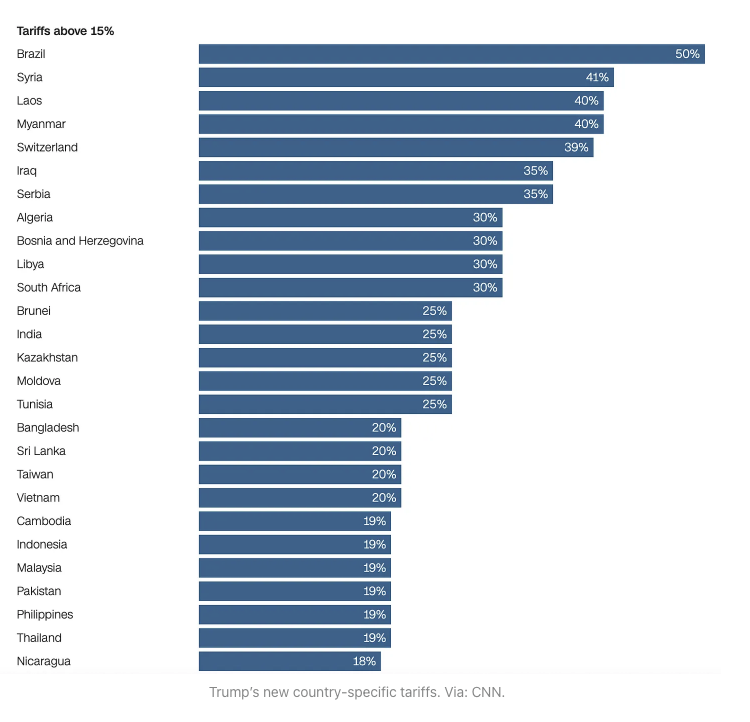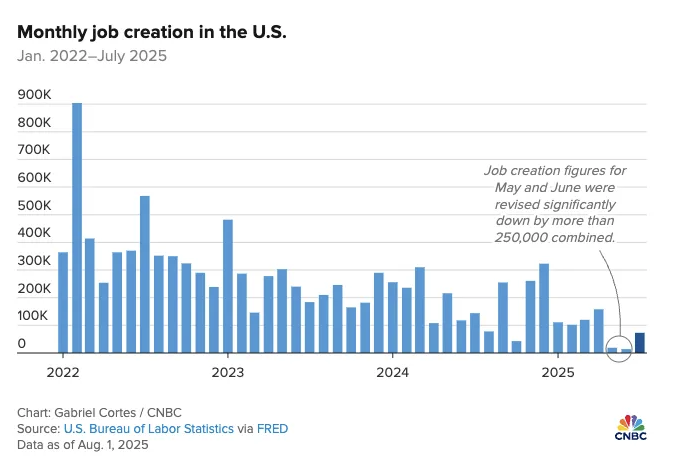Trump Announces New Wave Of Tariffs, Fires Labor Statistics Commissioner After Lower-Than-Expected Jobs Numbers
President Donald Trump’s tariffs did not take effect today — but the many countries that failed to make a deal with him ahead of the August 1 deadline will face even higher levies in a week.
Even though Trump officials promised “90 deals in 90 days” ahead of the deadline, frameworks for deals were only made with 11 of the top 15 U.S. trading partners. Tariffs on China and Mexico have been delayed as negotiations continue.
The White House announced sweeping new tariffs on goods imported from more than 67 countries Thursday night — raising rates to levels not seen in over a century. Markets did not react well to the news, with The Dow Jones Industrial Average dropping 542 points (1.2%), the S&P 500 dipping nearly 1.6%, and the Nasdaq down about 2.2% on Friday.
EVEN HIGHER RATES
Most of the new tariffs, ranging from 10% to 41%, will take effect on August 7, reportedly to give U.S. Customs and Border Protection time to prepare. It also gives the countries another week to try to negotiate them down, or delay them further. The White House cited the U.S. trade deficit as a threat to national security and the economy.
A 15% “universal” tariff will also be the new baseline rate for about 40 countries where the U.S. runs a trade deficit — up from 10%.
A trade deficit occurs when countries buy fewer U.S. goods than the U.S. buys from them.
More than two dozen countries will see higher rates than that, including India, Vietnam, and Cambodia, which are responsible for producing many electronics and clothing in the U.S. The White House claims their trade deficits are more extreme.
Canada and Mexico face separate hikes not covered by United States-Mexico-Canada Agreement (USMCA) exemptions. Canada’s rate will rise to 35% next Friday, while Mexico reached a temporary deal to keep its 25% rate for 90 more days.
The new tariffs raise the average import tax to more than 18% — the highest since 1934 — and are expected to cost the average U.S. family about $2,400 this year, according to the Yale Budget Lab. Tariffs are charged to US importers and then typically passed along to consumers, at least in-part, so they are called a “consumption tax” by some economists. Tariff rates had hovered between 2–3% before Trump’s second term.
TRUMP’S ECONOMY
Trump’s new wave of tariffs spooked markets, some of which had been surging to record highs in recent weeks.
Meanwhile, U.S. jobs numbers were also released Friday, showing lower-than-expected employment gains in the past three months. A few hours later, Trump announced on Truth Social that he fired the “Biden Appointee” commissioner of the Bureau of Labor Statistics, which issued the jobs report, accusing her, without evidence, of manipulating jobs numbers for political gain.
The recent report indicated that U.S. employers added just 73,000 jobs in July — well below expectations — and hiring in May and June was revised down by a combined 258,000 jobs. Those numbers signal a much weaker labor market this summer than previously reported. [Notably, the BLS often revises its jobs reports in subsequent months as they bring in more data.]
The updated figures show that only 14,000 jobs were added in June and 19,000 in May. That means only 106,000 jobs were created from May through July, compared to 380,000 in the prior three-month period.
The unemployment rate ticked up slightly to 4.2% in July.
Sectors that had layoffs: Factories cut 11,000 jobs in July, despite hopes that new tariffs would boost U.S. manufacturing. The federal government also shed 12,000 jobs last month — a fraction of the 84,000 federal workers that have been laid off since Trump took office.
For months, the Federal Reserve has held off on cutting interest rates due to concerns about inflation and tariffs, but newly revised data showing a sharp slowdown in hiring could increase pressure to lower rates — which Trump continues to urge.
BIGGER PICTURE
The report comes just days after GDP data revealed that consumer spending has slowed in the first half of 2025. With the recent jobs data and pending tariffs, the coming months are expected to bring more economic uncertainty for Americans — even as consumer sentiment was slightly up in July, though it remains lower than this time last year.




